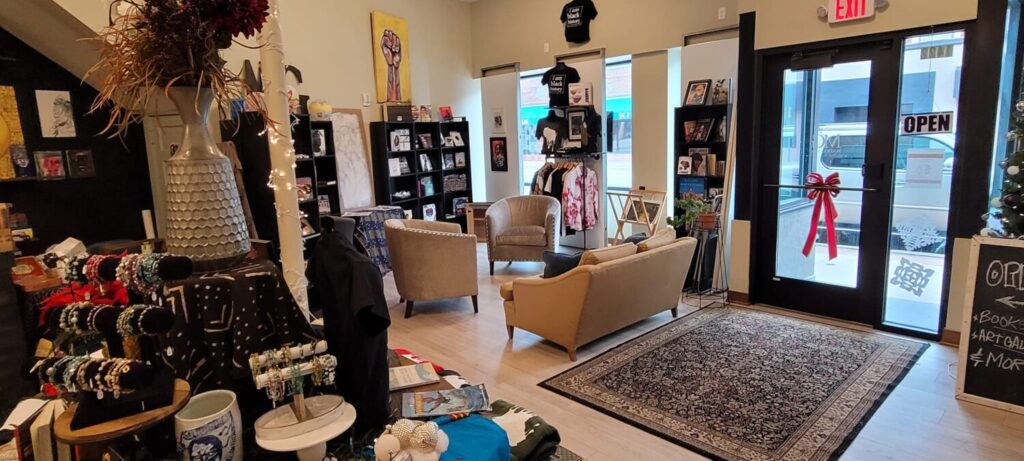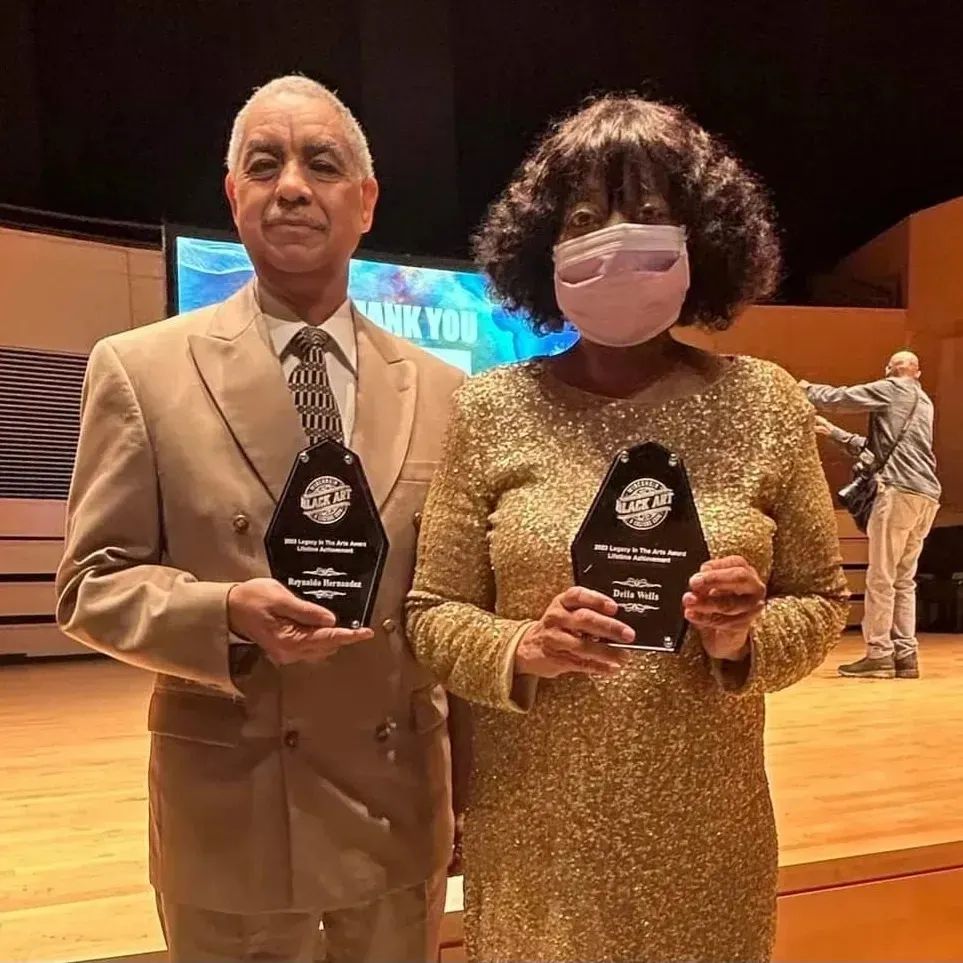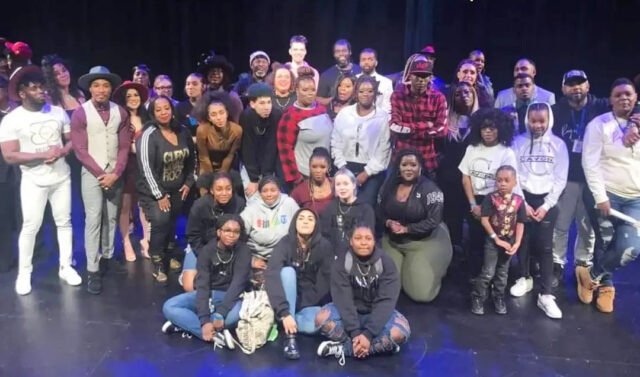Mahogany Gallery will be hosting the Night of Excellence Fashion Show as a culminating event for the 2nd Annual Wisconsin Black Art & Culture Expo (Expo2) on Saturday, March 25, 6 p.m., at UW-Parkside. Expo2 started back at the beginning of February with a Black Tie Gala, and has been filled with events, appreciations, and building connections. Scott Terry, founder and CEO of Mahogany Gallery, has been busy, and was excited to share the amazing work done so far, along with what is to come.
Gallery and Arts in Racine
After spending time in the corporate world and then moving on to teaching, Terry was sure his next move would be toward the art world. Terry is an artist himself, after all, and knew that there was potential in the Kenosha/Racine area for Black art to be both culturally and economically prosperous if given the platform. As a result, Terry started the Mahogany Gallery in 2019. While the physical location of the gallery was first in Kenosha, in 2020 a space in Racine opened up where it is currently located at 1424 Washington Avenue. Terry took a chance to make something he could bring to the community.
“I started the gallery in 2019, and I started because I felt there needed to be a space in my local community that supported and acknowledged Black creatives,” Terry told Madison365. “Here in the local community, but also regionally and across the United States as well. I’m a practicing artist, and I originally set out to create a studio of my own to get out of my house and have a standalone space to do my work and focus on my art practice. Then I realized that it would probably make sense and be beneficial if there was a space not for just me, but for other artists of color as well.”

What started off as a humble space still under renovation soon turned into a new home for Black art, culture, and history. Terry’s focus on seeing Black art and culture in a way that acknowledges the depth of the African Diaspora guided his ideas for creating a space where Blackness refuses to go unseen. Perhaps it was destined for Terry to find this space, as he also spoke to the history of the location itself.
“The space that I’m in now, used to be the site of a Black gallery in the ’80s in Racine, which was also very rare. The building was acquired and they modified the space, so that footprint of the old space is no longer here, but I do remember the artist,” Terry recalled, while sharing the sentiments he expressed with the late artist’s wife on the legacy of Black art.
“This space was destined to be another Black-owned art gallery in this community 30 years later. That’s the origin story of Mahogany Gallery. It’s a contemporary, commercial Fine Art Gallery. The only Black-owned one in this community, and one of the few in the state of Wisconsin.”
With power from the lasting legacy of Black contribution to the arts instilled in the space, the Mahogany Gallery serves as an example of how vital community spaces are. Beyond having an impact through initiatives like the Sentinel Mentors, the Mahogany Gallery also serves as a sort of center for Black literature in Racine. Terry spoke to the strength that can come from knowing just how pivotal Black culture was and is in a global sense.
“It’s not just a gallery, it’s a community space,” said Terry. “We host a lot of events from different organizations and individuals. That’s the space I went out to create, a community space with Black art and culture as the backdrop. There’s also a literature component here. There used to be a bigger focus on a bookstore component of our gift shop area, but we changed that up and now it’s more of a reference library. We have had received donations of a lot of literature from Black fiction, nonfiction, art biographies, art instruction, to local bank history, as well, and it’s more of a reference library for folks who want to learn more about all of our influence around the world in different aspects.”

Expo2 served as a special manifestation of the work and engagement Mahogany Gallery sets out to do year-round. Terry was especially appreciative of support from sponsors who have been eager to support the expo into its second year. While UW-Parkside has been especially impactful in helping facilitate events and give support, Terry feels the love across the community, and hopes that it can translate into growing in both knowledge and support of Black art and culture.
“We’ve got 16 sponsors this year, and I’m really excited about that,” Terry said. “We went from four at the beginning of this expo to 16 in one year. I’m really happy to see the community has really embraced the expo, and they’ve been supportive of it. This is really about an opportunity for us and the world to acknowledge our contributions to the arts in all of its forms. Not just here in Wisconsin, but throughout the region, as well as throughout the country and internationally, as well.”
History of Black social activism in Racine County
While Terry may have left the world of teaching in the context of a school, he was pleasantly surprised to find that teaching as a concept was not far from his work with the gallery. As Mahogany Gallery gained reference material, Terry followed his intention of sustaining history and passing on education through creating the Mahogany Black Arts and Cultural Center (MBACC).
“About a year or two later, we started the Mahogany Black Arts and Cultural Center, which is the nonprofit arm,” said Terry. “There’s the for-profit commercial gallery, and then there’s the nonprofit, where we’re doing three things; we charge ourselves with the preservation, research, and exhibition of Racine County Black history. If I were to ask anyone, ‘Where would you go to learn about Black history in Racine?’ There’s nowhere for someone to go to learn, there’s no physical home for that. That’s what we set out to fix, address, and accomplish.”
The mission to educate and sustain the history of Black culture, contribution, and existence in the area has been a journey according to Terry, who has learned plenty of local Black history himself on the way. While it is assumed that Black life was non-existent outside of city centers, mostly those in south-eastern Wisconsin, Terry has made it a priority to explore how Black people lived and left their impact on areas across Racine county, and across Wisconsin. Terry reflected on how one specific initial reaction to the news of their plans showed just how crucial seeking out the history is.
“One of the first comments that we got was a random comment from this guy who said, ‘There weren’t Black folks in Racine County in the 1800s.’,” Terry recalled. “I was like, ‘That’s not true.’ You can just imagine, if there’s no one there countering that, that would be the prevailing mindset … that we’ve had no influence or no contribution to Racine County since its beginning. It’s documented proof that that could not be further from the case.”
Terry specifically pointed toward records of conventions held in Racine County in the 1890s and 1920s. Such records around social issues of the time such as racism, policing, and economic development would be difficult to find without dedicated preservation of the history, and Terry looks to stand as that buffer. While simply preserving history is one thing, Terry was also insistent that it should serve as a lesson for today and a source of inspiration for continuing the work.
“It lets you know a couple of things,” Terry surmised. “One, that truthfully, collectively, not much has changed, and number two, people have historically organized and rallied around specific causes and issues related to Black people. That’s really encouraging to see that, and I feel like I’m standing on the shoulders of giants when I know that 100 years ago, there were people doing the same thing I’m doing. It’s within us to continue that legacy and to continue to do the work, because that’s what we’re supposed to do. Our ancestors would not have it any other way.”
Terry also spoke to the importance of oral histories, and how Black history and cultural education not being present in schools, even to the extent of being attacked if they are introduced, makes the issue of learning them that much more pressing. This is especially relevant for younger Black people and other people of color whose histories are often under-discussed in academic settings.
“As a culture, we’ve had to create our own lanes, to create our own spaces,” explained Terry. “For instance, the Green Book, that’s a perfect example of what we’ve done to work around and navigate roadblocks. It was a communication system that was for us, by us to help us travel safely across the country. That was one of the ways that we’ve navigated those obstacles, and art is another way we’ve navigated those obstacles. To be seen, to be heard, and to address systemic issues in a creative context that didn’t harm anyone else.”
One of the most impactful moments for Terry was hosting a local high school’s Black Student Union that came to visit the Mahogany Gallery before going to visit America’s Black Holocaust Museum. With opportunities to continue to teach and learn within the community, the Mahogany Gallery has already done its part in supporting the next generation.
The Future for Black Arts in Racine
The work is never done, though, and Terry would not have it any other way. As Terry discussed the excitement around Expo2 and the growth from last year, the people he recognized the most were the artists themselves. Terry discussed the difficulties working not only as a career artist, but as a Black career artist, especially in areas that are not widely recognized for their Black arts scene. As such, the Mohangony Gallery took this year’s celebrations as an opportunity to recognize those who have dedicated their lives to the arts.
“I’m a firm believer of acknowledging people and movements while those things are happening, because if you do not, it’s like it never existed,” expressed Terry. “Giving people their flowers while they can smell them. One of the things I’m really proud of that we did with the expo is we did our first Legacy in the Arts Awards, which went to people who are artists and other art appreciators who have spent 25 or more years in the arts practicing in various forms.”
The artist Della Wells was one such individual who received an award, whose work as a long-time practicing multimedia artist has cemented her legacy in Milwaukee’s Black arts scene. Fellow Milwaukee artist Reynaldo Hernandez also received an award for his mural work in the city which Terry said countless eyes have surely seen. Along with Bob Devin Jones for his work with The Studio@620 in St. Petersburg, Florida, Terry gave Jones praise for his uplifting of fellow visual artists.

(Photo supplied.)
“There were so many people who traveled from across the United States to Racine, Wisconsin, to celebrate and support Black artists,” Terry said in awe of the range of attendees from places such as Florida, Texas, New York State, and Chicago.
“People could see that the arts are an economic driver for communities. It can naturally support communities, it opens the door to bringing in tourism, and it opens the door to having conversations and dialogues that never transpired before,” he said. “This expo brought together organizations and people and entities that have never connected. And I’m really proud of the expo being able to do that.”
As Terry continues on the work to preserve Black history and platform Black artistry in the area, an important distinction he wanted to make was that appreciating Black art and history is for everyone. While there has been a backlash against the teaching of history and culture through Black perspectives or through a lens of critically engaging with systems of racism, Terry confirmed those reactions proved the gallery’s efforts were directed in the right place.
“What we’re trying to do is build these bridges across communities, and also educate our young people about the importance of knowing their history,” said Terry, “That’s a conversation we had too with them. Our history is so powerful that people want to diminish it, and people want to remove it, because they also know how powerful it is.”





























